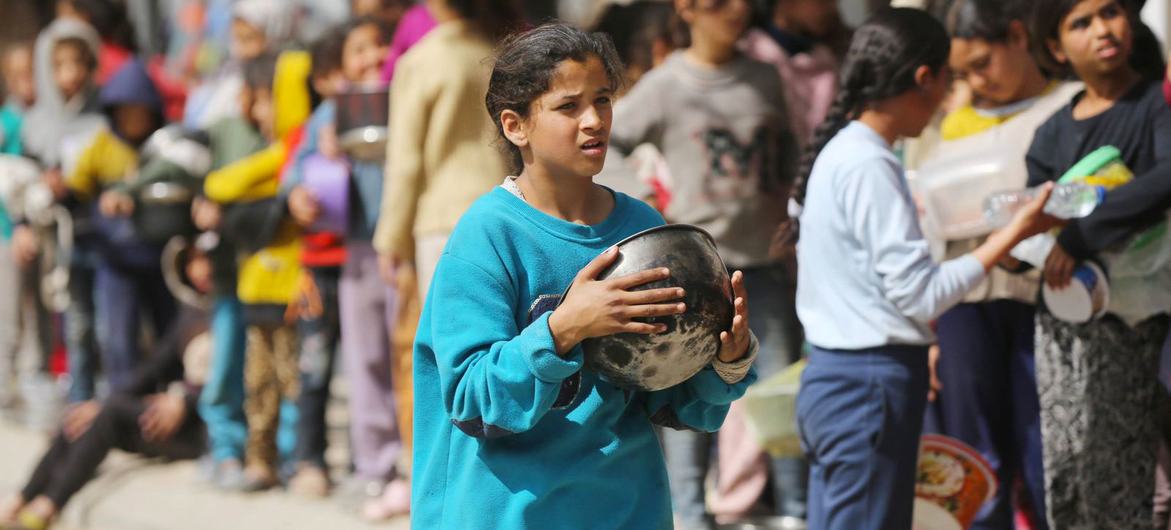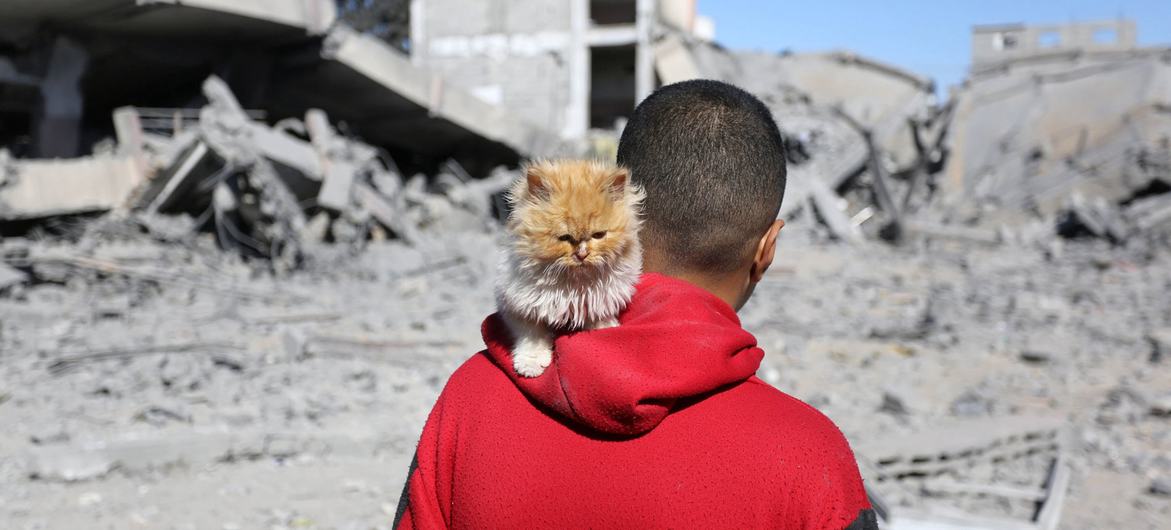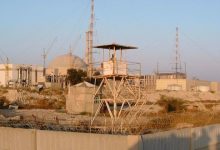Revamping Gaza: Gearin’ Up for the Post-War Rebuild
It’s still unclear how much more destruction and death Gaza will endure before peace settles across the troubled enclave, nor what type of society will emerge from the conflict, but six months after hostilities started UN agencies are already strategizing for the future, however uncertain.

© WFP
Some bakeries in Gaza are still operating.
Jobs and the economy
“Gaza has witnessed an almost complete destruction of economic activity in all sectors.” That’s the damning analysis of Aya Jaafar, an economist at the UN’s International Labour Organization (ILO).
The ILO estimates that more than 200,000 jobs have been lost in Gaza, some 90 per cent of the pre-conflict workforce. The UN agency further calculates that income losses there have reached $4.1 million per day, which equates to an 80 per cent decrease in the enclave’s GDP (the amount of money earned from the sale of all goods and services). This includes Palestinians who received salaries for work carried out in Israel but who are now unemployed in Gaza.
Construction has typically been one of the most important industries in Gaza, but according to the ILO, activity in the sector is down some 96 per cent. Other key productive areas, including agriculture and the industrial and services sector, have also all but ceased.
The few businesses that are still operating are generally small-scale local enterprises, including bakeries, other food-related businesses and some pharmacies.
What next?
The ILO estimates that perhaps 25 per cent of the people killed in Gaza have been men of working age – generally, women do not work. Ms. Jaafar said the loss of these “breadwinners” will mean that families “will face some economic hardships after the war ends”.
This could mean more children in a future Gazan labour market raising concerns about exploitative child labour.
In the immediate post-war situation, some emergency employment programmes will be “critical to provide incomes to workers who have lost their jobs” as they seek to support their families, Ms. Jaafar said.
It is expected that micro and small enterprises will need emergency grants and wage subsidies as part of the process of restoring activity and to facilitate local economic recovery. Extensive skills development and vocational training will also be required.
A key task for any future government of Gaza is to “identify economic strategies that aim not only at improving the economic conditions, but also ensuring that economic growth creates decent jobs”, she added.
Investment-heavy ILO programmes which provide employment opportunities for local communities while supporting the reconstruction or rehabilitation of the destroyed infrastructure will also play an important role.

© UNRWA
The people of Gaza are expected to need humanitarian aid for many years to come.
Feeding Gaza
Access to food has remained a critical concern of humanitarians since the early days of the conflict and, according to FAO’s AbdelHakim Elwaer, “many in the north do face a serious situation of malnutrition, starvation with some of the population classified as being hit with famine.”
Before the conflict, Gaza had a thriving agricultural and fisheries sector both for export and local consumption. Indeed Gaza had “partial self-sufficiency of production of fruits and vegetables”, he said.
The sector has largely collapsed due to the relentless bombing across the enclave. Almost 50 per cent of agricultural land has been destroyed according to Mr. Elwaer.
Much of Gaza’s food needs were met by imports by the private sector, but that supply chain has all but collapsed.
Some livestock is still farmed, but animal feed, which some Gazans are now reportedly eating for lack of other food, has been in short supply. FAO reported that it took three months to get approval from the Israeli authorities for a delivery of 500 tonnes of feed.
Reactivating local production
“The people of Gaza are ready to reactivate local production,” said Mr. Elwaer, “but they require seeds, fertilizers and pesticides.”
While small-scale farming may be relatively straightforward to kick start, revitalizing the commercial agricultural sector to its pre-7 October level will be more challenging.
“Over 50 per cent of all agriculture assets have been destroyed, so massive investment will be needed,” said Mr. Elwaer. “We need to recover what’s been damaged, rebuild capacity and then hope the private sector will re-engage.”
He believes that the recovery will be humanitarian-led for at least two years until there is “some level of stability, trust and confidence” which will allow people to return and revive their businesses.

© UNRWA
A man looks at the devastation in a neighbourhood in Gaza.
The cost and timetable of reconstruction and recovery
It is too early to say how much it will cost to rebuild Gaza as the destruction is continuing.
However, according to Rami Alazzeh of the UN Conference on Trade and Development (UNCTAD), “it will take decades and the will of the international community to fund tens of billions of dollars of investments to reconstruct Gaza.”
The World Bank calculates the figure at $18.5 billion, but that only accounts for damage up until the end of January 2024. Housing will be most costly to rebuild (taking up 72 per cent of the overall costs) followed by public service infrastructure such as water, health and education (19 per cent).
That figure obviously does not include the costs of keeping people alive with humanitarian assistance over the next several years. And deadly unexploded bombs will also have to be cleared across the enclave which, according to the UN’s Mine Action Service, “will take years”.
Weighing some big “ifs”
It is not immediately clear if the money for reconstruction will be forthcoming, and there are some other big “ifs.”
If reconstruction were to start immediately after hostilities ended and if the Israeli blockade of Gaza, which has been in force for 18 years, was ended and if Gaza were able to sustain a 10 per cent growth over the coming years, it would take until 2035, for the enclave “to get back to where it was prior to the 2006 blockade”, according to Mr. Alazzeh.
However, in the worst-case scenario, where the economy grows by 0.4 per cent a year, as has been the case in recent years, then Mr. Alazzeh believes it will take Gaza “until 2092, or seven decades, just for it to go back to its economic level of 2022”.
Politics will play a role as well, according to the UNCTAD expert.
“The cycle of destruction and insufficient reconstruction is not an option for the people in Gaza,” he said. “We need to restore hope in people for the future, and I think that only comes through a comprehensive political plan which includes the two-State solution.”
Simon Blake is an experienced journalist deeply interested in international affairs and global development. Having spent years reporting on humanitarian issues, he offers a unique perspective in his coverage of United Nations news.




It is concerning to see the devastating impact on jobs and the economy in Gaza. The steep decline in economic activity and the staggering job losses paint a bleak picture for the future of the enclave. It’s imperative that comprehensive plans are put in place to rebuild and revitalize the economy to ensure sustainable growth and prosperity for the people of Gaza.
Do you think implementing new economic policies could help kickstart job creation in Gaza? What specific measures could be taken to revive the economy?
Implementing new economic policies could indeed be a crucial step in kickstarting job creation in Gaza. Specific measures such as investment incentives, vocational training programs, and support for small businesses could help revive the economy and create employment opportunities for the people of Gaza.
“It’s heartbreaking to see the dire situation in Gaza unfold. The loss of jobs and economic devastation is painting a grim future for the people there. It’s crucial that international efforts ramp up to rebuild and uplift Gaza’s economy for a more hopeful tomorrow.”
It’s heartbreaking to see the devastating impact the conflict has had on Gaza’s economy. The loss of jobs and income is staggering, and the future remains uncertain for the people of Gaza. Let’s hope for a swift and successful reconstruction process that can bring back hope and prosperity to this troubled region.
It is devastating to see the impact of the conflict on Gaza’s economy. The numbers provided by the ILO paint a bleak picture of the job losses and income decline. The reconstruction efforts will need to focus on revitalizing these sectors to ensure a stable future for Gaza.
It’s heartbreaking to see the devastating impact of the conflict in Gaza on the economy and job market. I believe it’s crucial for international organizations like the UN to come together and support the rebuilding efforts to restore hope and prosperity for the people of Gaza.
How is the UN planning to address the staggering job losses and economic devastation in Gaza post-war?
The UN is working on comprehensive strategies to tackle the alarming job losses and economic devastation in Gaza post-war. Initiatives include job creation programs, vocational training, and support for small businesses to revitalize the economy and provide livelihood opportunities for the affected population. It’s a challenging task, but vital for rebuilding and stabilizing the region.
It’s devastating to see the economic impact on Gaza. The statistics provided by the ILO are truly alarming. Let’s hope for swift progress in rebuilding the economy and restoring livelihoods in the region.
Will the UN agencies’ strategies be sufficient to kickstart economic activity and create new jobs in Gaza post-war?
It’s heartbreaking to see the devastating impact of the conflict on Gaza’s economy. The statistic that 200,000 jobs have been lost is alarming, and the 80% decrease in GDP paints a grim picture of the current situation. Let’s hope for a swift and effective rebuild to bring back stability and hope to the people of Gaza.
How are the UN agencies strategizing for the future amidst such uncertainty in Gaza?